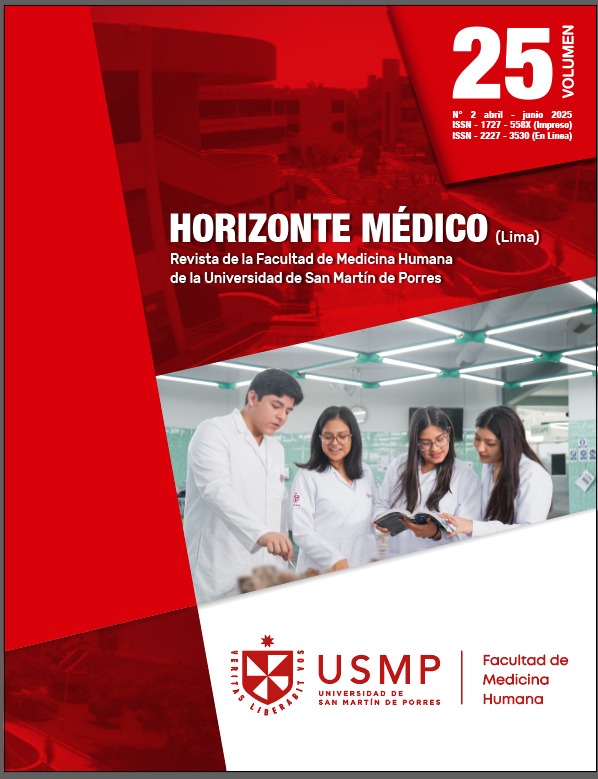Septic shock caused by Salmonella: still drawing attention
DOI:
https://doi.org/10.24265/horizmed.2025.v25n2.12Keywords:
Shock, Septic, Blood Culture, SalmonellaAbstract
Salmonella infection is uncommon, but carries a high mortality rate if the patient develops
hemodynamic instability. It predominantly affects children and the elderly. The mechanisms
by which nontyphoidal Salmonella causes urinary tract infection are generally attributed to
hematogenous spread resulting from gastroenteritis or to the introduction of fecal microbiota
through the urethra. In this case, the patient presented with a clinical picture characterized by
the onset of watery stools accompanied by emesis and followed by urinary symptoms.
The presented clinical features prompted the development of this case report, which aims to
provide guidance in identifying risk factors and clinical manifestations that may raise suspicion of
Salmonella as the etiology. The patient had a history of acute gastroenteritis, after which urinary
symptoms and septic shock developed. The bacillus was isolated in both blood and urine cultures
and was found to be sensitive to ciprofloxacin, the first-line antibiotic due to its intracellular
activity. This case underscores the importance of rational antibiotic use in the light of the
emergence of beta-lactamase-producing Salmonella in Paraguay.
This case report is noteworthy due to the infrequency of urinary tract infections with septic shock
caused by Salmonella. In this context, it is important not only to know the clinical syndromes that
may be attributed to this bacillus, but also to highlight the patient’s socioeconomic background,
since the infection is associated with the consumption of contaminated liquid or food.
Downloads
References
Alfaro-Mora R. Aspectos relevantes sobre Salmonella sp en
humanos. Rev Cuba Med Gen Integral [Internet]. 2018;34(3):110-
Disponible en: http://scielo.sld.cu/scielo.php?script=sci_
arttext&pid=S0864-21252018000300012
Martinez E, Osorio J, Delgado J, Esparza GE, Motoa G, Blanco VM, et
al. Infecciones del tracto urinario bajo en adultos y embarazadas:
consenso para el manejo empírico. Infectio [Internet]. 2013;17(3):122-
Disponible en: https://www.revistainfectio.org/P_OJS/index.
php/infectio/article/view/619
Yuste JR, del Pozo JL, Carmona-Torre F. Infecciones del tracto
urinario. Med - Programa Form Médica Contin Acreditado [Internet].
;12(51):3020-30. Disponible en: https://doi.org/10.1016/j.
med.2018.03.004
Berrospi C, Callupe G, Cachay C, Arteaga F. Infección del tracto
urinario por Salmonella no typhi en paciente diabética. Rev Peru
Investig Salud [Internet]. 2018;2(1):74–7. Disponible en: https://
revistas.unheval.edu.pe/index.php/repis/article/view/217
Parra-Payano V, Rondón-Paz C, García C. Salmonelosis invasiva en un
hospital de Lima, Perú. Rev Peru Med Exp Salud Publica [Internet].
;36(3):464-8. Disponible en: http://dx.doi.org/10.17843/
rpmesp.2019.363.4330
Arguello L. Situación epidemiológica del VIH [Internet]. Paraguay:
Ministerio de Salud Pública y Bienestar Social; 2021. Disponible en:
https://www.mspbs.gov.py/dependencias/pronasida/adjunto/5e8632-
InformeEpidemiolgicoVIH2021.pdf
Altaf A, Tunio N, Tunio S, Zafar MR, Bajwa N. Salmonella urinary
tract infection and bacteremia following non-typhoidal Salmonella
gastroenteritis: an unusual presentation. Cureus [Internet].
;12(12):e12194. Disponible en: https://doi.org/10.7759/
cureus.12194
Melgarejo N, Martínez M, Franco R, Falcón M, Álvarez M, Ortiz H, et
al. Primer aislamiento de Salmonella Javiana con portación de KPC-
en Paraguay. Rev Salud Pública Parag [Internet]. 2017;7(2):51-6.
Disponible en: https://doi.org/10.18004/rspp.2017.diciembre.51-56
Ramos JM, Aguado JM, García-Corbeira P, Alés JM, Soriano F. Clinical
spectrum of urinary tract infections due to nontyphoidal Salmonella
species. Clin Infect Dis [Internet]. 1996;23(2):388-90. Disponible en:
https://doi.org/10.1093/clinids/23.2.388
Salvatierra G, Rimac R, Chero A, Reyna I, Rosadio R, Maturrano
L. Resistencia antimicrobiana y genotipificación de cepas de
Salmonella Typhimurium aisladas de cuyes (Cavia porcellus)
provenientes de granjas de producción intensiva de la ciudad de
Lima, Perú. Rev Investig Vet Peru [Internet]. 2018;29(1):319-27.
Disponible en: http://www.scielo.org.pe/scielo.php?script=sci_
arttext&pid=S1609-91172018000100031
Durán C, Luna L, Carhuaricra D, Salvatierra G, Maturrano L, Rosadio
R. Evaluación de factores de virulencia en cepas de Salmonella
Typhimurium aisladas de cuyes (Cavia porcellus) enfermos y
sanos. Rev Investig Vet Peru [Internet]. 2021;32(5):e21331.
Disponible en: http://www.scielo.org.pe/scielo.php?script=sci_
arttext&pid=S1609-91172021000500021
Mansilla M, Morales-Cauti S, Dellepiane-Gil H, Chuquizuta C.
Resistencia antibiótica de cepas de Salmonella entérica aisladas de
canales de cuyes en un mercado de Lima, 2021. Rev Investig Vet Peru
[Internet]. 2023;34(1):e24595. Disponible en: http://www.scielo.org.
pe/scielo.php?script=sci_arttext&pid=S1609-91172023000100026
Crump JA, Sjölund-Karlsson M, Gordon MA, Parry CM. Epidemiology,
clinical presentation, laboratory diagnosis, antimicrobial resistance,
and antimicrobial management of invasive Salmonella infections. Clin
Microbiol Rev [Internet]. 2015;28(4):901–37. Disponible en: https://
doi.org/10.1128/cmr.00002-15
Kassise E, Kassise J, Abadía-Patiño L. Neumonía necrotizante y empiema
pleural por Salmonella no Typhi en paciente inmunocompetente. Bol
Venez Infectol [Internet]. 2020;31(1):25-8. Disponible en: https://
docs.bvsalud.org/biblioref/2020/10/1123248/02-kassise-e-25-28.pdf
Arenas-Rojas AM. Infección en el sistema nervioso central por
Salmonella: reporte de tres casos. Rev Mex Pediatr [Internet].
;83(4):124-7. Disponible en: https://www.medigraphic.com/
pdfs/pediat/sp-2016/sp164d.pdf
Downloads
Published
How to Cite
Issue
Section
License
Copyright (c) 1970 Horizonte Médico (Lima)

This work is licensed under a Creative Commons Attribution 4.0 International License.
Horizonte Médico (Lima) (Horiz. Med.) journal’s research outputs are published free of charge and are freely available to download under the open access model, aimed at disseminating works and experiences developed in biomedical and public health areas, both nationally and internationally, and promoting research in the different fields of human medicine. All manuscripts accepted and published in the journal are distributed free of charge under the terms of a Creative Commons license – Attribution 4.0 International (CC BY 4.0).


















